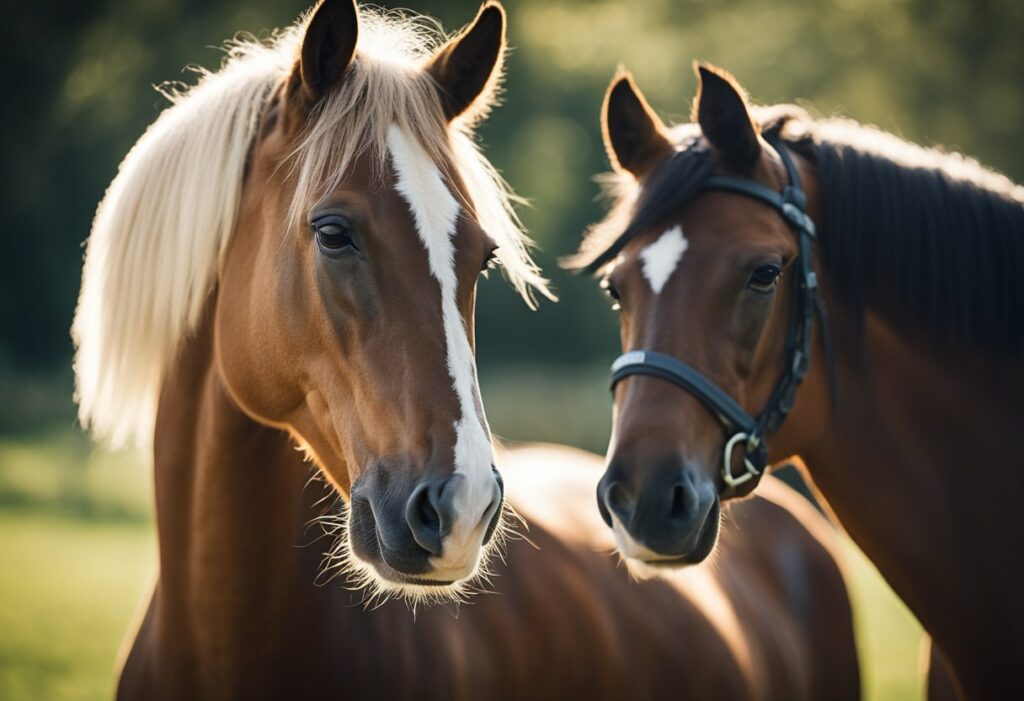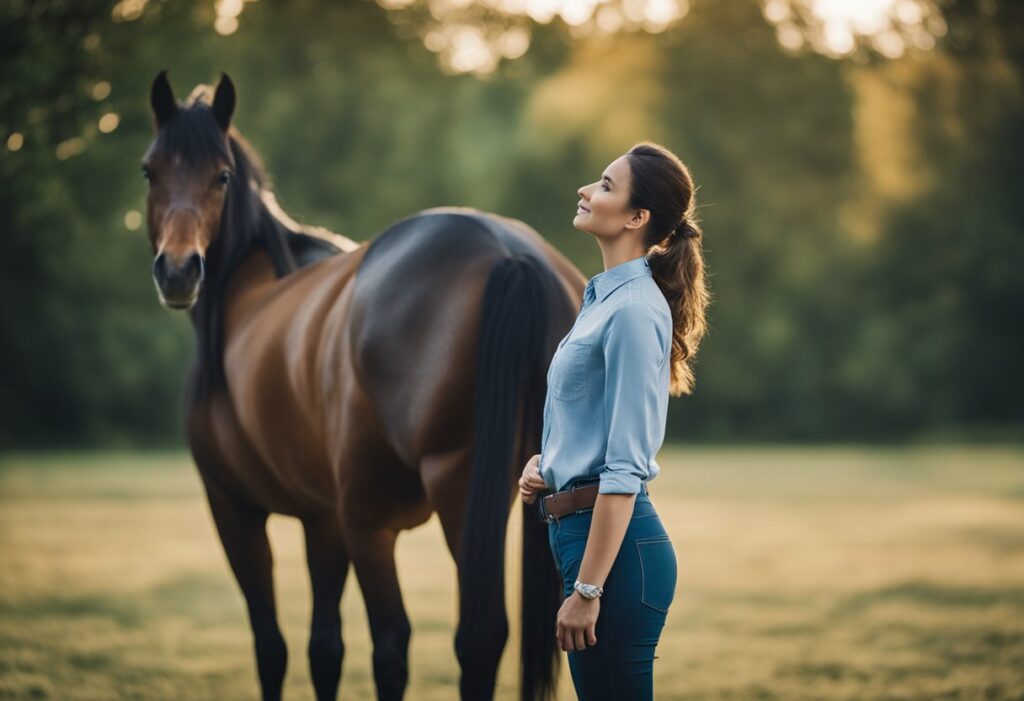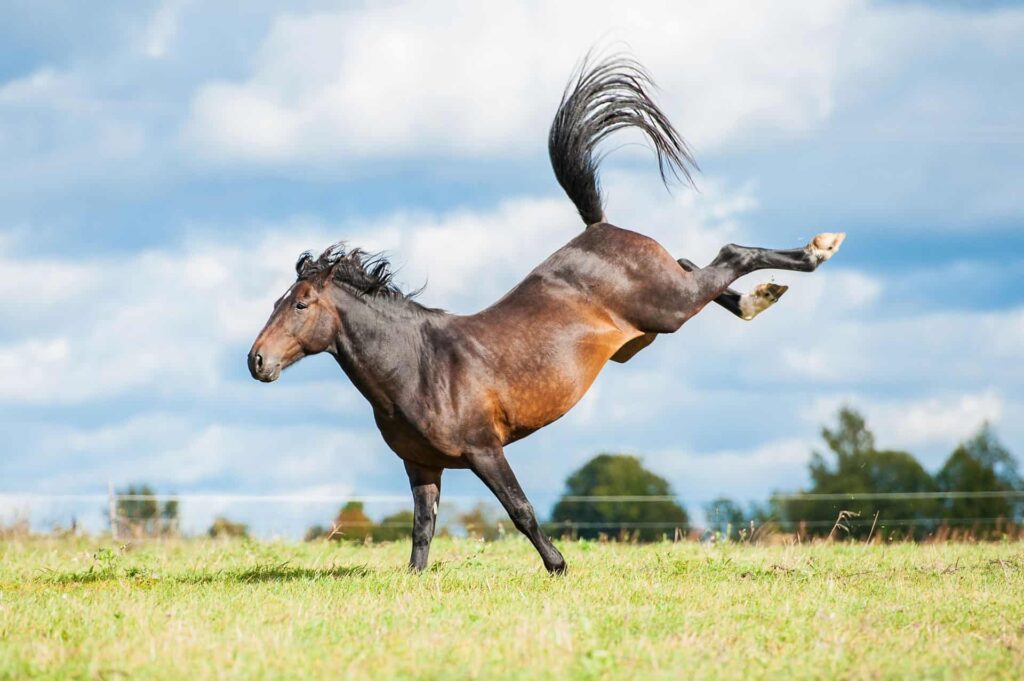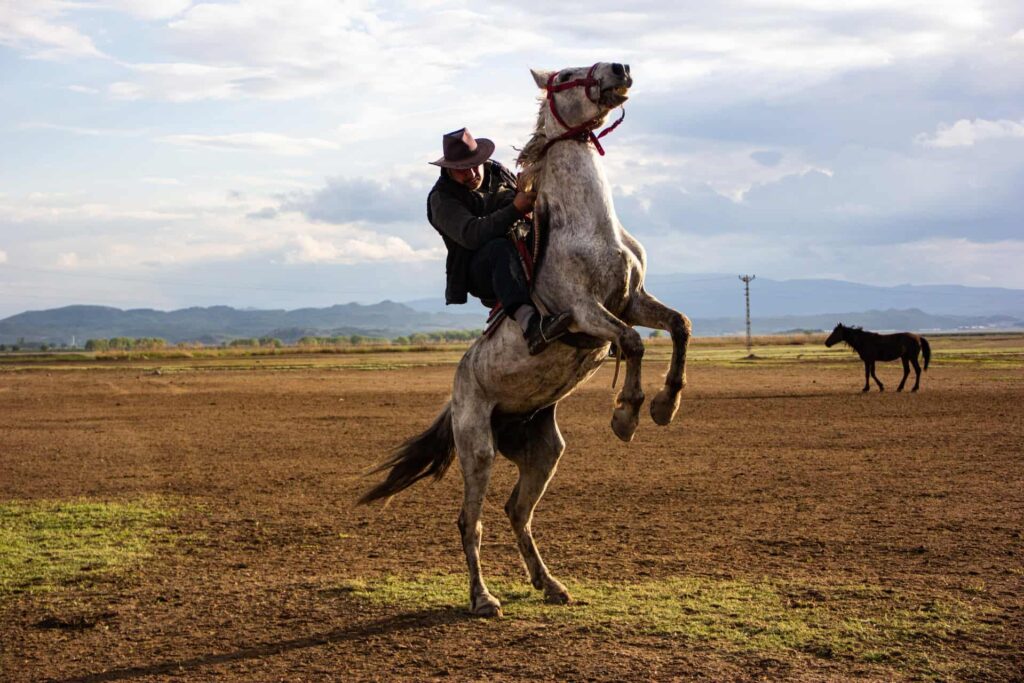Horses are sensitive and intelligent creatures that, like humans, can experience stress and anxiety. Understanding the sources of their anxiety and learning how to establish trust with a horse is crucial for both the animal’s well-being and the safety of the people around them. There are various practical horse training techniques that can help to keep a horse calm and composed in different situations.
As unpredictable as horses can be, knowing how to observe and interpret their body language will help establish a strong bond while building trust. This, in turn, lays a strong foundation for successfully calming an anxious horse. Ensuring that a horse’s nutritional needs are met can play a role in maintaining their overall mental and emotional health.
Key Takeaways
- Building trust and understanding a horse’s anxiety is important for their well-being
- Practical techniques and body language interpretation can effectively calm a horse
- Proper nutrition plays a crucial role in managing a horse’s anxiety levels
Understanding a Horse’s Anxiety
Horses, just like humans, can experience fear, anxiety, and worry. Recognizing and addressing these emotions in horses is crucial for their well-being and successful interaction with humans. This section will discuss the behavioral signs of anxiety in horses and some common causes of nervousness.
Behavioral Signs of Anxiety
Anxious horses often display a range of behaviors that indicate their discomfort. Some typical signs include:
- Restlessness and pacing
- Sweating and increased respiration rate
- Tail swishing and head tossing
- Ears pinned back
- Nervous and, in some cases, aggressive behavior
Be observant of these signs in order to identify a stressed or anxious horse and take appropriate measures to calm them.
Common Causes of Nervousness
There are several potential reasons for a horse’s anxiety, including:
Young horses: Inexperienced and young horses may often be more nervous due to their limited exposure to various situations. As they get older, with proper training and handling, they typically become more confident and less anxious.
Older horses: Alternatively, some older horses may develop anxiety due to bad experiences in the past or a decline in their physical abilities.
Individual personalities: Just like humans, horses have distinct personalities. Some horses are naturally more anxious and sensitive than others, while some may be confident and calm.
Environment and handling factors: Certain environmental and handling factors contribute to a horse’s anxiety. Examples include a new environment, loud noises, sudden movements around them, or the presence of unfamiliar people and animals.
Physical discomfort and pain: A horse experiencing physical discomfort, such as a poorly fitted saddle or an injury, may exhibit anxiety and nervousness.
Understanding the causes and signs of anxiety in horses is crucial for ensuring their well-being and maintaining a positive relationship between horses and humans. Properly caring for and handling a horse can help reduce anxiety and create a more relaxed and comfortable environment for them.
Building Trust and Bond with a Horse

Importance of Calm Energy
Maintain a calm and composed demeanor when interacting with horses. Horses are highly sensitive animals and can easily pick up on the energies and emotions of those around them. Displaying calm energy is reassuring to the horse, helping it feel more comfortable in your presence.
To project a sense of calm, maintain steady breathing and a relaxed body posture. The more composed you are, the more likely the horse will be to reciprocate that sentiment and remain calm as well.
Talk and Use of Voice
Talking to your horse can significantly improve the bond between you and the animal. Your voice can convey reassurance, safety, and comfort, which can be crucial elements in building trust. When speaking to your horse, maintain a gentle tone and avoid sudden changes in volume, as these might startle or agitate the animal.
Some ways to use your voice effectively include:
- Greet the horse by its name, building familiarity and association.
- Provide clear, concise verbal commands accompanied by appropriate body language.
- Praise the horse when it responds well to your cues, reinforcing positive behavior.
- Utilize calming phrases and a soothing tone when the horse seems nervous or agitated.
By incorporating these strategies, you can foster a deeper bond with your horse while simultaneously cultivating a sense of calm and trust.
Practical Techniques to Calm a Horse
Use of Lead and Tack
Using a lead rope and the right tack can greatly contribute to calming a horse. When working with a nervous horse, it’s important to move slowly and deliberately, ensuring that the animal doesn’t feel threatened. The choice of tack should provide comfort and security for the horse, so be sure to select the right type and size. Properly adjusting the tack can prevent pinching and discomfort, allowing the horse to relax and feel at ease.
- Make sure the tack is clean and in good condition
- Use a soft and comfortable lead rope
- Spend time with the horse, so it gets used to you handling its tack
Dressage and Exercise
Dressage and exercise are effective techniques to help a horse relax and focus. When a horse is engaged in regular, structured exercise, it tends to be more balanced and confident in its movements. Dressage specifically targets the horse’s coordination, attention, and obedience, providing a controlled environment for the horse to develop a trusting relationship with its rider.
On the other hand, regular exercise, such as turnout or lunging, promotes a sense of calm in horses. A consistent routine allows horses to burn off excess energy and release stress, leading to a calmer demeanor.
Here are some suggestions for implementing dressage and exercise:
- Establish a consistent exercise routine
- Gradually introduce dressage exercises to build the horse’s skills and trust
- Ensure that the horse is appropriately exercised, considering its age, breed, and fitness level
- Regularly monitor the horse’s progress and adjust training as needed
By following these practical techniques in using a lead and tack, as well as implementing dressage and exercise, you can effectively calm a horse and foster a positive, trusting relationship between horse and handler.
Lowering Horse’s Head to Signal Relaxation
One of the natural ways to calm a horse and promote relaxation is by encouraging the horse to lower its head. Lowering a horse’s head has physiological benefits, as it puts the horse at ease and makes it easier to handle. This technique is great during groundwork exercises and establishing a more harmonious relationship with your horse.
Slow Approach and Pressure Management
When approaching a horse to initiate the head-lowering process, maintain a slow and steady pace. Horses are prey animals by nature and can become tense or anxious if they perceive sudden movements or aggressive behaviors from their handlers. By approaching the horse with confident and calm energy, you will promote trust and relaxation in your equine partner.
While working with a horse to lower its head, managing pressure is key. Begin by standing next to the horse’s head, and gently apply downward pressure on the lead rope or halter. As the horse starts to lower his head, release the pressure slightly to reward the horse for responding positively to your cues. Through repetition and consistent handling, the horse will learn that lowering its head results in reduced pressure, reinforcing the relaxation effect.
As you become more experienced with this technique, you can introduce additional elements to further promote relaxation in your horse. Incorporating gentle massages, ear rubs, or even utilizing calming signals can strengthen the bond between you and your equine partner, ultimately making your horse more relaxed and easy to handle.
By incorporating the technique of head lowering into your handling and training routine, you will foster a sense of trust, relaxation, and safety for your horse. Maintain a consistent, calm, and gentle approach when working with horses to ensure they remain at ease and receptive to your guidance.
Dealing with a Spooked Horse
Recognizing Danger Signs and Techniques to Refocus
Horses are sensitive creatures, so it’s not uncommon for them to become spooked by sudden movements or unfamiliar objects. Recognizing the warning signs and knowing how to calm a frightened horse is important to maintain a safe, enjoyable riding experience.
When a horse is spooked, there are several danger signs to look out for. Their body language can change quickly, including tensing muscles, raising their head, and widening their eyes. The horse may also snort or stamp its feet, indicating a heightened sense of fear. In some cases, the horse may rear, bolt, or kick if the situation escalates to a state of panic.
To refocus a spooked horse, the first step is to remain calm and composed. Horses are perceptive animals and can sense your emotions, so if you are nervous or agitated, it can worsen the situation. Speak softly and reassuringly to the horse, using familiar commands if appropriate.
One helpful technique is to redirect the horse’s attention away from the cause of the spook by gently tapping its neck or shoulder. This tactile communication can help bring the horse back to a state of attentiveness, and moving its focus away from the scary stimulus can have a calming effect.
In addition, try to keep the horse moving forward, or if it’s more agitated, encourage it to perform slow, deliberate movements such as circles or figure-eights. This can help regain control and redirect its energy into a more constructive outlet.
It’s crucial to remember that each horse is unique and may respond differently to various calming techniques. Practice patience, stay aware of the horse’s reactions, and do not hesitate to try alternative methods if some are not effective. Continuously working on building trust with your horse through regular, calm interaction can also greatly help when handling a spooked horse in the future.
Professional Assistance and their Role
When to Call a Veterinarian
In certain situations, it may be necessary to consult a veterinarian to provide guidance on how to calm a horse. For example, if the horse is displaying signs of pain, distress, or anxiety that cannot be managed through training or handling alone, a veterinarian’s expertise may be required. They can help in diagnosing the cause of the horse’s distress and suggest appropriate medical treatments or interventions to alleviate the problem.
Veterinarians are also trained in the use of sedative medications, which can be carefully administered to a nervous or agitated horse in order to facilitate treatments or procedures. However, sedatives should only be used under the guidance and supervision of a professional, as improper use may have negative consequences for the horse’s health and well-being.
Involvement of Horse Riding Professionals
Apart from veterinarians, horse riding professionals like trainers and instructors play a crucial role in helping a horse stay calm and well-behaved. These professionals have extensive experience and knowledge of various techniques to train and handle horses effectively.
A competent rider can help a horse relax by employing proper riding techniques, such as maintaining a balanced seat, using appropriate leg and rein aids, and staying in tune with the horse’s motion. When a horse senses that the rider is confident and in control, it is more likely to remain calm and composed.
Trainers can guide horse owners in implementing groundwork exercises that help build trust and communication between the owner and the horse. This may include lunging a horse, free schooling, and targeted desensitization exercises. The trainer’s expertise can prove invaluable in instilling a sense of calmness in the horse and ensuring a positive, productive partnership between the horse and its human counterparts.
When aiming to calm a horse, utilizing the assistance of veterinarians and horse riding professionals can help achieve successful outcomes. Their knowledge, skills, and experience are invaluable resources that can help ensure the well-being of the horse while providing guidance for effective training and handling techniques.
Importance of Nutrition in Managing Horse Anxiety

Proper nutrition plays a significant role in maintaining a horse’s physical and mental well-being. It can impact their mood, stress levels, and overall behavior. In this section, we will discuss the importance of nutrition in managing horse anxiety and how supplements and dietary adjustments can help calm a nervous horse.
Role of Supplements and Dietary Adjustments
1. Increase fat intake: Adding more fat to a horse’s diet can promote calmness. A high-fat diet has been shown to have a calming effect on their behavior. Sources of fat include vegetable oils, rice bran, and flaxseed.
2. Magnesium supplementation: Magnesium is a mineral that plays a crucial role in muscle and nerve function. Anxiety can be linked to magnesium deficiency, so providing a magnesium supplement can help reduce anxiety levels in horses.
3. Proper forage and grazing time: Ensuring your horse has access to good quality forage and enough time to graze in the field can help reduce anxiety. Horses are natural grazers, and denying them the opportunity to fulfill this behavior can lead to increased stress levels.
4. Avoid high sugar and starch diets: Horses fed a diet high in sugar and starch can exhibit anxiety and aggression. Switching to a low-starch, high-fiber feed can help improve their behavior and calmness.
Managing a horse’s anxiety levels is important for their overall well-being and performance. The use of supplements and dietary adjustments can help calm a nervous horse and promote a more relaxed demeanor. Carefully considering your horse’s nutritional needs can significantly impact their mood and stress levels, resulting in a happier, healthier horse.
Frequently Asked Questions
How do you settle a nervous horse?
Settling a nervous horse requires patience, understanding, and consistent training. Start by establishing trust through positive reinforcement, physical touch, and grooming. Slowly introduce the horse to new experiences and situations while maintaining a calm demeanor yourself. Remember that horses can sense our emotions, so it’s important to stay relaxed and reassuring.
What are effective methods for soothing an anxious horse?
Several methods can help to soothe an anxious horse. One approach is to use a familiar object or scent, such as a favorite blanket or a calming essential oil like lavender. Another tactic is to provide a quiet, consistent environment that minimizes sudden changes and disturbances. Maintaining a steady routine, including regular exercise and feeding times, can also help keep a horse calm and relaxed.
What groundwork exercises help ease a horse’s anxiety?
Groundwork exercises, such as lunging, round pen work, and in-hand training, can help build trust and ease a horse’s anxiety. These exercises teach the horse to respond to cues, develop obedience, and improve communication between the horse and the handler. Practice these exercises regularly, integrating challenges and new elements gradually to help the horse build confidence and coping skills.
Are there natural remedies to relieve horse stress?
Yes, there are various natural remedies that may help relieve stress in horses. Some options include calming supplements such as magnesium, chamomile, or tryptophan. Aromatherapy using calming essential oils like lavender can also help. Consult with a veterinarian or equine nutritionist before introducing any supplement or remedy to your horse.
How can you handle separation anxiety in horses?
Managing separation anxiety in horses often involves gradual desensitization. Start by separating the horse from its companion for short periods and slowly increasing the distance and duration over time. Providing distractions, such as toys or treats, can help keep the horse occupied and lessen anxiety. Encourage independence by varying routines and companions so that the horse builds confidence in different situations.
What is the most efficient calming solution for horses?
The most efficient calming solution for a horse depends on the individual animal and the cause of the anxiety. In many cases, combining a balanced routine, positive reinforcement, consistent training, and natural remedies can provide an effective and holistic approach to reducing stress and anxiety in horses. It’s important to monitor the progress and adjust the strategy based on the horse’s needs and response.
Last Updated on October 22, 2023 by Nate Dewsbury



